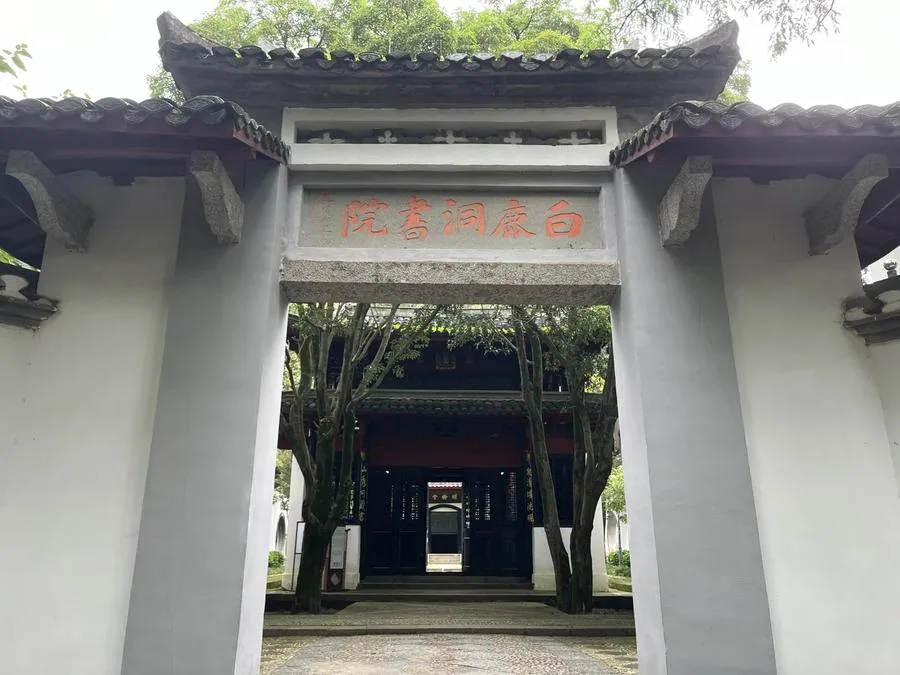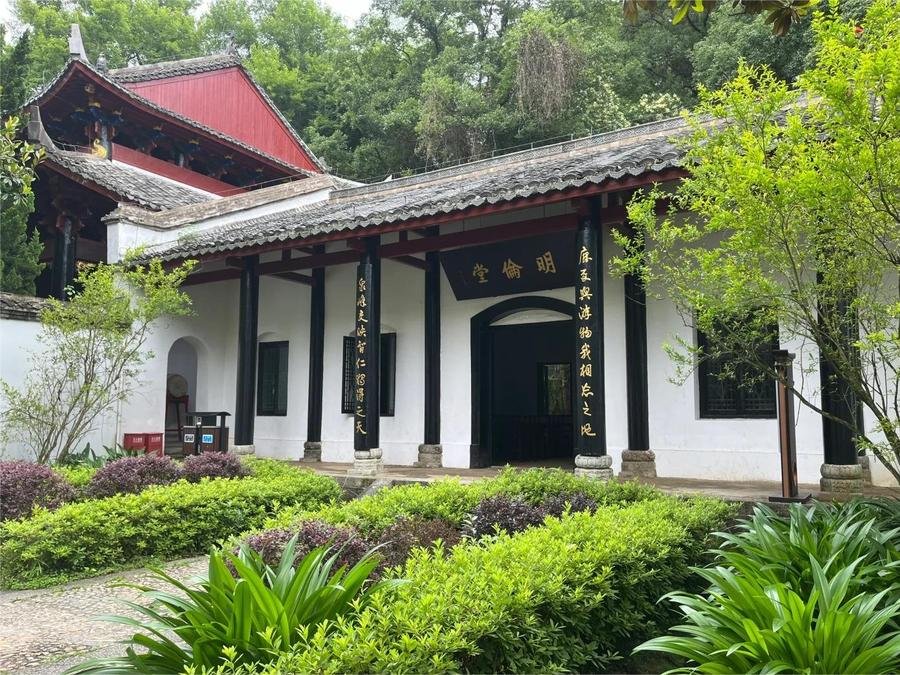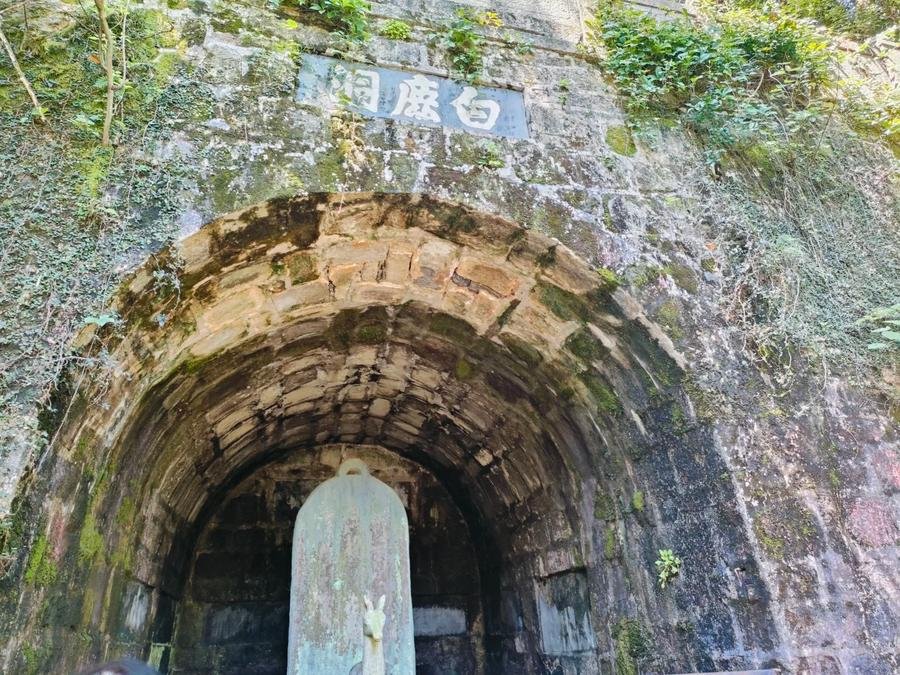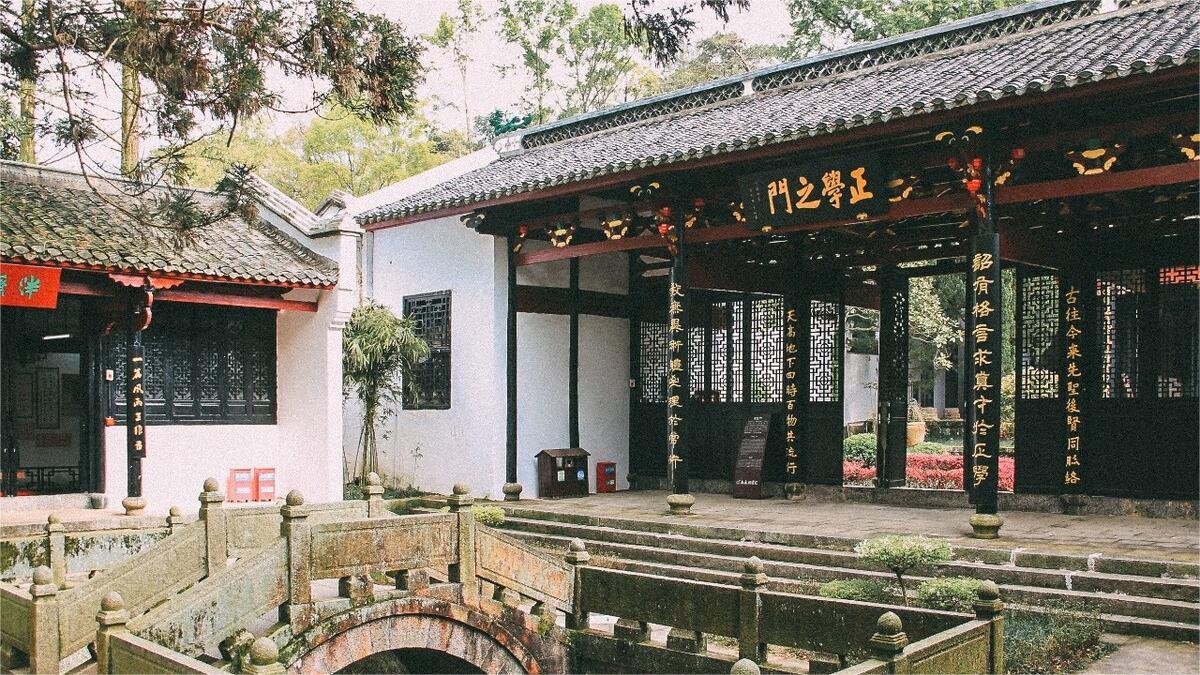White Deer Cave Academy (Bailudong Academy, 白鹿洞书院), located in Lushan Mountain, Jiujiang City, Jiangxi Province, is one of China’s four great academies, alongside Yuelu Academy in Changsha, Songyang Academy in Dengfeng, and Yingtian Academy in Shangqiu. During the Zhenyuan period of the Tang Dynasty, Li Bo, the governor of Jiangzhou, retired here to study and raise a white deer for amusement, earning him the nickname “White Deer Gentleman.” He built terraces and planted flowers and trees, which led to the establishment of the academy. The academy experienced periods of prosperity and decline until it flourished again when the renowned Southern Song Dynasty scholar Zhu Xi lectured there. The academy now has a history of over 1,000 years.
The architectural complex of White Deer Grotto Academy is arranged in a series along the Guandao Stream from west to east. The academy itself is the third group among five courtyards, situated east of the Lingxing Gate Courtyard and west of Ziyang Academy. The White Deer Grotto Academy is oriented north to south and consists of three courtyards. The layout is carefully designed, forming a large quadrangle structure. The buildings are primarily stone-wood or brick-wood structures, mostly from the Ming and Qing dynasties, with gabled roofs. Notable buildings and attractions within the academy include the Imperial Book Pavilion, Minglun Hall, White Deer Cave, and Sixian Terrace.
Table of Contents
- Basic Information
- Location and Transportation
- Highlights of White Deer Academy
- History of White Deer Academy
- Other Attractions in Mount Lu
Basic Information
| Estimated Length of Tour | 1 – 2 hours |
| Ticket Price | 40 RMB |
| Opening Hours | 8.00 – 17.00 |
| Telephone Number | 0086-0792-8792291 0086-0792-8793902 |
Location and Transportation
White Deer Grotto Academy is located on the southern slope of Wulao Peak in Lushan Mountain, Jiujiang, Jiangxi Province. To get there from Jiujiang Station, you can either ride a shared electric bike or walk to the Changhong Overpass East Bus Station. From there, take bus number 63 to the East Gate of Lushan Mountain.
Highlights of White Deer Academy
Entrance Gate

The entrance gate of White Deer Grotto Academy is an elegant structure made of brick, wood, and stone in an octagonal shape. It features a double-eaved gable roof covered with gray tiles. Below the eaves is a long rectangular frame with five perforated cross-shaped leaves. Below this is a granite stone plaque inscribed with the characters “白鹿洞书院” (White Deer Grotto Academy). The gate itself has a stone beam and brick columns on both sides. Inside the gate is a courtyard with side rooms to the east and west and the Imperial Book Pavilion to the north. The front part of the courtyard is paved with blue bricks, while the rear part is paved with granite, blue bricks, and cobblestones. The west side room is also known as the east side room of the Yang Pool, with the couplet on the corridor pillars reading, “Rain refreshes the zither and books, and the wind brings the fragrance of calligraphy.” The couplet on the east side room pillars reads, “Beside a hundred-year-old tree, reading ten thousand volumes of books.”
Minglun Hall

Minglun Hall, also known as Yilun Hall, was constructed in the third year of the Zhengtong period of the Ming Dynasty (1438) by Zhai Pu, the governor of Southern Tang. This hall is a brick-wood structure with a gabled roof covered in gray tiles. It has four bays and a front corridor. Minglun Hall served as the lecture hall of the academy. A couplet hanging outside the hall reads, “Deer and swine wander here, where things and self are forgotten; springs and peaks reflect each other, in a world of benevolence and wisdom.”
Imperial Book Pavilion

The Imperial Book Pavilion, also known as the Shengjing Pavilion or Shengzhi Tower, was first built in the eighth year of the Chunxi period of the Southern Song Dynasty (1181). The pavilion primarily houses imperial gifts such as the “Annotations and Commentaries on the Thirteen Classics,” “Twenty-One Histories,” “Ancient Literary Yuanjian,” and the “Complete Works of Zhu Xi.” The pavilion is a two-story wooden structure with a square floor plan and a surrounding corridor. In the center of the second floor hangs a vertical plaque inscribed with “御书阁” (Imperial Book Pavilion). The pavilion has a hip roof, and the columns outside bear the couplet: “The clear spring can wash the inkstone, and the beautiful mountains can store books.”
White Deer Cave

White Deer Cave is a semicircular stone cave carved into a mountainside, measuring over 4 meters in height, width, and 6 meters in depth. The interior walls are lined with granite stones, and the floor is paved with stone bricks, all quite smooth. A small stone deer is crouched on a stone base inside the cave, with a stone stele behind it inscribed with “The Stele of Cai Gong, Grand Secretary and Grand Administrator, Rejuvenating White Deer Cave,” written by Xiong Weidian during the Shunzhi period of the Qing Dynasty. Initially, the site was famous but without an actual cave. In the ninth year of the Jiajing period of the Ming Dynasty (1530), Wang Zhen, the governor of Nankang, conducted a ceremony to create the cave. Wang Zhen also wrote an article titled “A Message to Future Scholars on the New Cave,” explaining that while White Deer Cave was renowned, it lacked an actual cave. Creating the cave would preserve the legacy of the sages and inspire future generations. On the front wall of the cave is Wang Zhen’s inscription, “Record of the Deer Cave.”
Sixian Terrace

Sixian Terrace was constructed in the ninth year of the Jiajing period of the Ming Dynasty (1530). In the 30th year of the Jiajing period (1551), Cao Bian, the inspector of Jiangxi, built a pavilion on the terrace, named Sixian Terrace, implying “seeing the terrace and thinking of virtuous people.” The terrace has a square layout with a wooden pavilion also in a square shape. The pavilion features a double-eaved gable roof supported by two-tiered dougong (interlocking wooden brackets) and has one central door with wooden lattice windows on all four sides. The front is protected by a granite railing. Surrounding the terrace are stone railings with stone carvings. Notable inscriptions include “The Origin of Neo-Confucianism” by Hengya, “Sixian Terrace” by Liu Shiyang, “The Place of Aspiration” by Qin Dakui, and “A Pavilion in the Sky, a Tranquil Universe” by Li Ziyuan.
History of White Deer Academy
The White Deer Grotto Academy, one of China’s four great academies, is located in Lushan, Jiujiang, Jiangxi Province. The academy has a rich history dating back to the Tang Dynasty.
In 785 AD, during the first year of the Zhenyuan period of the Tang Dynasty, Li Bo and his brother Li She from Luoyang secluded themselves in Lushan. Li Bo, known as “Mr. White Deer,” kept a white deer for amusement.
In 825 AD, during the first year of the Baoli period, when Li Bo became the magistrate of Jiangzhou, he built a terrace at his old residence, channeled water, and planted flowers, naming it “White Deer Grotto.”
In 940 AD, during the fourth year of the Kaiyuan period of the Southern Tang Dynasty, Li Shandao, Zhu Bi, and others established Lushan Guoxue (National Academy) at the site, which became known as “White Deer National Treasury,” “White Deer National Academy,” and “Kuangshan Imperial College,” comparable to the Nanjing Imperial College.
At the beginning of the Song Dynasty, it was expanded into an academy, ranking alongside the Suiyang, Shigu, and Yuelu academies as one of the four great academies.
In 976 AD, during the ninth year of the Kaibao period of the Northern Song Dynasty, Song troops occupied Jiangzhou, ending the history of Lushan Guoxue. In 1002 AD, the grotto was renovated, and statues of Confucius and his disciples were sculpted. In 1053 AD, Sun Chen built ten houses at the grotto, known as “White Deer Grotto Academy,” and local magistrate Guo Xiangzheng wrote the first inscription for the academy, “Record of the White Deer Grotto Academy.” In 1054 AD, the academy was destroyed by war.
In 1179 AD, during the sixth year of the Chunxi period of the Southern Song Dynasty, the philosopher and educator Zhu Xi was appointed to inspect the site. Despite his efforts to restore the academy, he initially received no support from the government. By March 1180 AD, the academy was partially restored. In 1217 AD, Zhu Xi’s son, Zhu Zai, as the director of the Dali Temple, completed the restoration.
In 1233 AD, Jiangdong inspector Yuan Fu renovated and expanded the academy, writing “Record of the Renovation of White Deer Academy” and “Record of the White Deer Academy Junzi Hall.” In 1287 AD, during the 24th year of the Zhiyuan period of the Yuan Dynasty, the academy underwent restoration with local government support. During the Dade period (1297-1307 AD), Yu Ji’s “New Record of White Deer Grotto Academy” mentioned the addition of over 400 mu (about 27 hectares) of academic land. In 1351 AD, the academy was destroyed by war.
In 1438 AD, during the third year of the Zhengtong period of the Ming Dynasty, magistrate Zhai Pufu led officials and gentry to rebuild the academy, laying the foundation for its Ming and Qing dynasty structures. In 1442 AD, inspector Zhang Qian suggested the construction of key buildings, which were completed with Hu Yan’s written “Record of the Reconstruction of White Deer Grotto Academy.”
In 1465 AD, the academy was further developed by Jiangxi educational inspector Li Ling and magistrate He Jun. In 1492 AD, the first gazetteer of the academy was published by magistrate Guo Jin. In 1579 AD, much of the academy’s land was requisitioned for military use, causing a temporary closure until its restoration in 1583 AD. By the late Ming Dynasty, the academy had become more governmental in nature, with official oversight.
In 1650 AD, during the seventh year of the Shunzhi period of the Qing Dynasty, donations led to repairs and expansions. In 1662 AD, Governor Zhang Chaolin led efforts to rebuild the Minglun Hall and the Ancestral Shrine. From 1677 AD onwards, under the support of officials, the academy underwent extensive renovations, including 74 rooms and 65 additional buildings, totaling 139 rooms. In 1687 AD, Emperor Kangxi personally inscribed plaques for the academy.
In 1902, the academy ceased operations, and its land was managed by the local middle school. A fire in 1911 resulted in the loss of most of its collection. In 1918, Kang Youwei inscribed the academy’s name, and occasional repairs were made.
Since 1949, the site has been managed by local cultural and educational departments. In the 1950s, the East and West Stele Galleries were built. By the mid-1980s, the government of Lushan had restored several key buildings, including the Minglun Hall (Yilun Hall) and the Imperial Book Pavilion, along with other structures.








